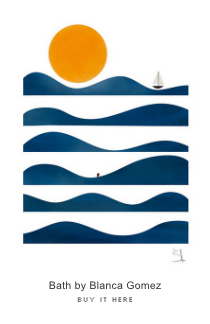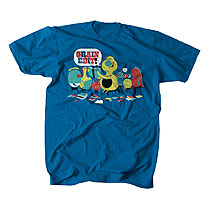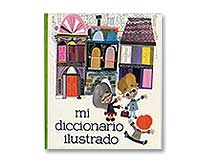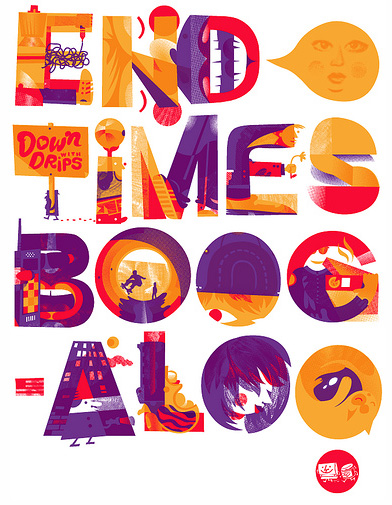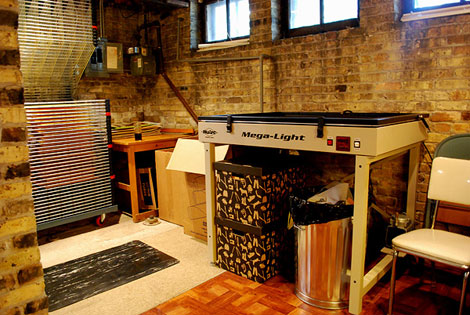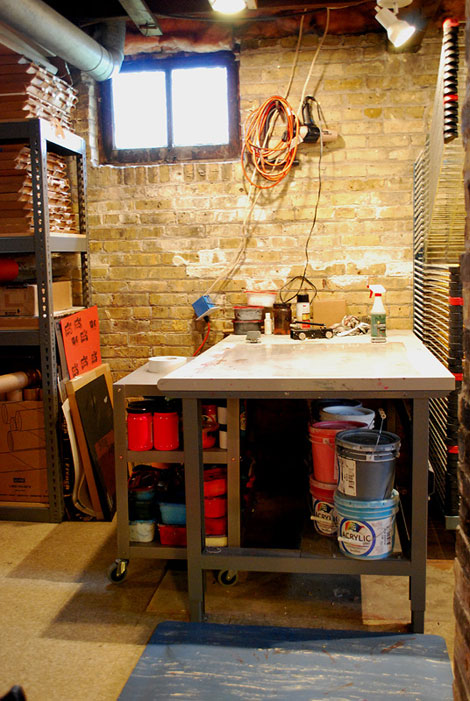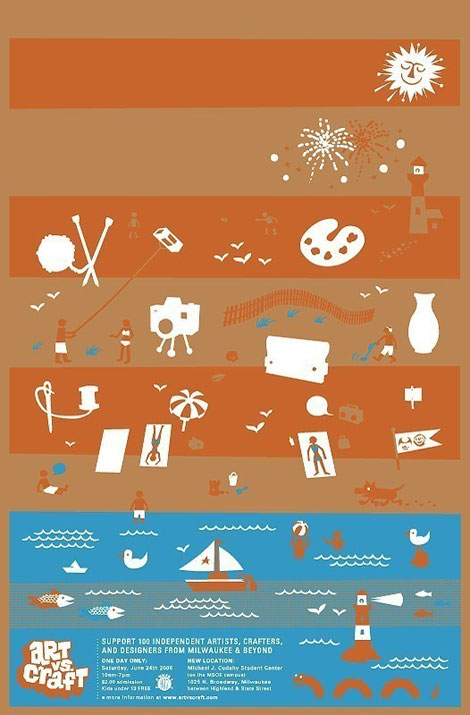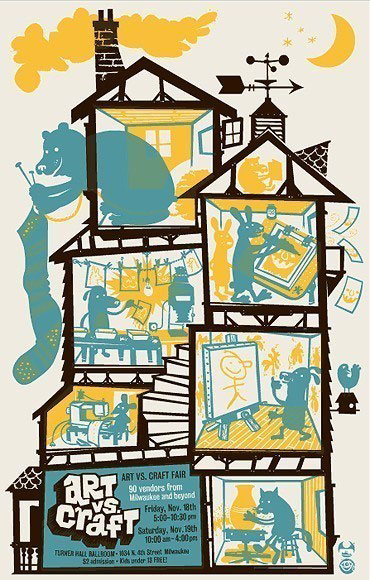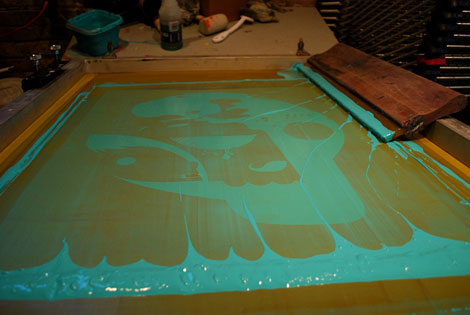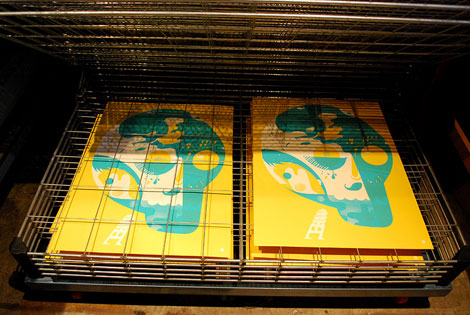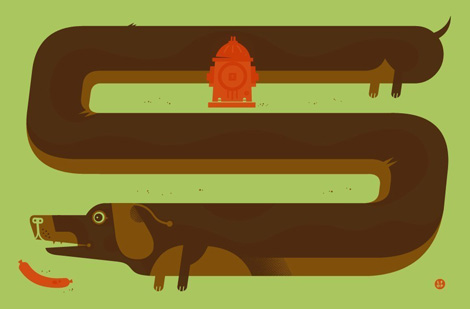Little Friends of Printmaking interview
(Photo credit: C. Taylor)
The latest installment to the Grain Edit interviews takes us to Milwaukee, Wisconsin: home to big name breweries, delicious Gouda, and husband-wife design duo…The Little Friends of Printmaking!
Melissa and JW Buchanan are the brains behind the Little Friends, and they are best known for their often outrageously intricate prints that explore everything from the complexities of the mind, fun-loving animals, to leisure time activities.
In this interview, they discuss the perks about working with their significant other, the highs and lows of attending art school, and their creative process.
And now, let the fun commence!
Where are you from originally?
Melissa: I grew up in Milwaukee. So imagine my chagrin that as an adult I would move back here.
JW: I grew up in a shitty little industrial town in southern Minnesota called Austin. It was completely flat and there was nothing around but windblown prairie dirt in any direction for fifty miles at least. Bleak. When I meet other people from Minnesota and they ask where I grew up, they say, “…Oh,” in that knowing way. (It’s not an endorsement).
What do you guys like best about Milwaukee? Would you ever consider moving?
JW: Well, it sounds like a terrible cliché, but I genuinely fear moving because we’re so accustomed to fresh beer, and incredible cheese and sausage. Did I say incredible? I think I meant phenomenal. An aged Gouda that will make the little hairs on the back of your neck stand on end. It’s too bad because I think the major design capitals don’t share our commitment to dairy.
Melissa: We came to a consensus recently, and it was this: We like to live here, but we DON’T want to die here. We’re due for a move soon. It is hard for us, because we’d have to drag our studio with us across the country, so we have to be really, really sure we’re moving to the right place.
How did you decide on the moniker “The Little Friends of Printmaking?”
JW: How to tell this story without repeating ourselves horribly…
Melissa: The Little Friends of Printmaking was at first a sham student organization that our friend Joe started so that he could rent vans from the university. James and I came up with the name because we got really sick of people calling us at home to ask if they could join the organization, which they couldn’t, because it was fake.
JW: The nerve of those people!
Melissa: So we came up with the Little Friends name in order to drive people away…to make it sound like something nobody would want to have anything to do with…like a bunch of creepy printmakers in polar fleece vests and lavender jeans who want to be your little friend. And then later, we decided to make it a real student organization that actually did things, because why not?
JW: Ultimately we adopted the name for ourselves. It suits us, I think.
How did you both meet?
JW: We met in art school at the University of Wisconsin in an epically humiliating cut-and-paste-the-little-paper-squares foundations course. It was awful and we bonded over its awfulness.
Melissa: It was a long, drawn-out flirtation. We would draw things to impress each other. We were also in a race to see who could most completely blow off that class. I won.
That’s so cool! How long have you guys been together? What is like working with your significant other?
JW: We’ve been together for like, eleven years, and married for almost nine.
Melissa: Working together is so easy, eleven years in. The beginning was a little rough sometimes. I think at first the emotional stakes were high because every little design job felt like a make-or-break proposition, and we were married…not just partners. So, it felt really important to agree all the time. Over the course of a partnership, though, everybody gets their own way a little. It works out.
Do you ever get tired of working with one another?
JW: I don’t. Having someone whose eye and taste you can trust is a huge luxury. There aren’t that many people who I trust that way, and Melissa is at the top of the list.
Melissa: I hate it. It’s terrible. Don’t tell James.
Would you want to collaborate with any other artists?
JW: I wouldn’t rule it out, but there’s such strange alchemy involved in collaboration. It can turn out so crummy.
Melissa: Over the past few years, we’ve worked with some cool designers on making screenprints for them, ushering them through the basics of the process, helping them turn their idea into a really good design for print. That’s been interesting.


Do you ever create individual work? Or is it collaborative all the time?
JW: I guess that we must, just in the course of making so much stuff, but we don’t make a distinction. It’s not important to us.
When did you first become interested in printmaking?
Melissa: I first did printmaking in high school. It instantly appealed to me – I liked that there was a process and that involved planning and executing a series of tiny steps. I also enjoy vacuuming and reorganizing my record collection. I am very dull.
JW: My high school didn’t offer printmaking so I had to take a graphics course in the school annex, next to the auto shop in a room that intensely smelled of acetone and possibly gave me brain cancer.
I wouldn’t say you’re dull! I enjoy those activities too. What are your guys’ 3 favorite records?
Melissa: Wrong: I am super boring.
JW: We have a super-clean 7” of “I Can’t Get Through to You” by The Honeycombs which to me is like the apotheosis of the whole Joe Meek thing. Another favorite is a 7” of “We Want to Parrty Parrty Parrty” by Lyn Collins with the rare alternate b-side, “You Can’t Beat Two People in Love.” Both that and “I Can’t Get Through to You” are such desperate, paranoid songs. They’re kind of amazing. And then we just picked up a beautiful copy of “Volume Two” by The Soft Machine which is a longtime favorite but we’ve never had it on vinyl.
What was the first drawing/print you remember making and how old were you?
Melissa: I don’t know if I could remember the first drawing I made. I refuse to tell you about the first print I made on the grounds that it could incriminate me as a total loser, but I can tell you that it was shown at the Wisconsin State Fair. It won a blue ribbon, which puts it on equal footing with the best goose blood porridge or best pig.
JW: I hope the guy that judged the artwork was the same guy that judged Best Pig. I made screenprinted stickers with my name on them. Whee!
Did you attend art school? If so, how did you like it? What advice would you give to recent graduates?
JW: Yeah, we went to art school. I think my enduring impression of school is kind of negative. I learned a lot in art school – I can’t deny that. But for us, the main benefit of being at art school was the unfettered access to the facilities. We tried to make the most of that; I mean we really, really cranked out the work.
As far as advice: This is something I’ve said before, but if you’re in art school, you’re essentially paying people to look at your work and take it somewhat seriously. I used to get something out of that; but then we started doing posters and design work that reached a wider audience, where the success or failure of something became definitively less subjective. Then I was like, “ya’ll have been replaced, bitches!” (I didn’t really say that, but you can imagine.) So my main advice to recent graduates is that the flow of good and bad advice that comes from critique will eventually get shut off, so maybe come up with your own way of getting your work in front of people and make things that interest people and are, somehow, a part of their lives. (And do so without spending a huge amount of money.)
Melissa: I mostly liked being in art school for the side benefits. For instance, school allowed me to work for years as an assistant preparator at an art museum. That was an awesome job. Really, whether I liked the entire experience or not is clouded by the fact that I got so little sleep, I barely remember it.
What was your first design gig?
JW: Our first paid design work was doing screenprinted posters for a club in Madison that no longer exists. They were a punk vegan co-op in the basement of a church and so they had very limited credibility to people who did not already know they were having cool events. “Follow me into this darkened church basement. Les Savy Fav is playing. Really! This is not a trick, I promise. There is no cult indoctrination down here, seriously.” Not very convincing.
Melissa: The promoter had seen an art show of ours and thought our work would translate well into posters. We did a couple just for giggles and when people were still asking us about them six months later (and if we were going to make any more) we figured we were on to something.
Nice! What current projects are you working on? Anything fun and exciting?
JW: Various NDA stuff (mostly print stuff and apparel) and then also art prints. Also something so exciting I can’t talk about it even though I haven’t signed anything. I’m convinced that if I talk about it then it won’t happen. !!! It’ll be crushed beneath the weight of expectations.
Melissa: Our latest series of BAD VIBES art prints is coming out soon. It’s exciting to get back to just making artwork.
JW: We’re also supposed to redesign our website, which we’ve been putting off for years. Now that everybody’s fixing up their websites en masse in their idle hours, we look perhaps even lazier than before (maybe).
Do you guys have any art shows coming up?
Melissa: We’ll be showing some stuff at the Flint Institute of Arts in September. We just did something for a group show here in town, and for the “Meanwhile…” show at Subtext in San Diego, and for the “Printed Matter” and “Free to a Good Home” shows at GR2 in Los Angeles. We’ve had a few offers for a new solo show but nothing’s been nailed down yet. Watch the skies!
What is a typical day for you like?
JW: We get up around 10am, do our best to answer emails and take any calls we have to take, and we work until past midnight. I try to take a bike ride, if I can, before the sun goes down. That’s about it. I never leave the house. Come and get me, burglars.
Melissa: We also have food breaks occasionally. We print something every weekend. We used to try to print a small amount every night, but I started dreading it so we backed off a bit.
How would you describe your creative process?
JW: Everything we do is really more concept-driven than not. We’re idea people, not stylists; which I guess makes our process more like a designer’s than an illustrator’s. We feel like we need to be fairly certain about our concept before we start anything, so a lot of what we do is decided upon before we even pick up a pencil. We have a nice, sunny room where we can sit and hash out ideas; we live near the beach which gives us lots of room to pace around and stare into the distance like a couple of idiots. We also do a ton of “research.” Yes, it looks like fucking around on the internet, reading books and watching television, but it’s really work. Really! You have to train yourself to process the things you see into things you can use in your work. You have to always be looking.
Melissa: Research is so important. You can’t operate in a vacuum. And that extra time you put into researching something pays off tenfold in nuance and smart little details that people remember.
JW: You get that extra time back. Like, at the end of your life.
Melissa: We’re pretty much anti-sketching. Our sketches are very rough and extremely small. And we usually make just one sketch.
JW: You’re taught that you sketch and you sketch, and then you start to fall in love with the little bits and pieces and so you develop those further in another sketch, and so on. That always seemed like a waste of energy to me. Obviously it works just fine for thousands of other people. But I’ve never been a sketcher. I remember having to fabricate hundreds of fake sketches at the end of the semester in art school, because sketching was compulsory.
Melissa: Ha!
JW: So at this point we have a concept and a permanent-marker sketch that’s like 2” x 3”. And so then we just work.
Melissa: We work in Flash, and then Illustrator. Obviously, silkscreen is the main influence on our aesthetic and our process, because we do so much of it. When we’re working, we just sort of automatically set things up for silkscreen, even when we know it’s not going to be printed that way. It’s become how we draw, how we deal with color and texture. It’s how our brains work now.
JW: I guess it doesn’t seem like an earth-shattering revelation or anything, but when we’re designing something for silkscreen, we’re designing it in layers basically from the jump, instead of starting with a drawing and then separating it out, reverse-engineering it into a print. You have to let a print be a print.
Melissa: Did I mention that we design things about half-size, so they don’t get too complicated?
JW: We set up our color separations as a multi-paged pdf and go to the architectural printers’ or Kinko’s to get them printed out on bond paper with an oversized laser plotter. Lots of people prefer to turn their separations into film positives, and there are some major benefits, but bond paper saturated with vegetable oil is a way cheaper and greener solution.
Melissa: We a use photo-sensitive emulsion for our stencils, and yes, we bought a real exposure unit instead of building one, or trying to use the sun, or having a closet full of halogen lamps, or whatever. When you’re doing your own printing, there are lots of areas where you can cut corners or invent your own method, but some things you just can’t skimp on. An clean, reliable exposure is one of them.
—
Melissa and JD were kind enough to show us process images of creating their latest poster for Sonic Youth:

Here’s the sketch for the Sonic Youth poster we did this month. Our sketches are tiny and crummy because of our distaste for sketching (see above) but also because it makes sense for us. A poster needs to communicate from 20 feet away, or further. So, if it doesn’t work at two inches tall, right in front of your face, then think again. Already, though, the basic idea is here. You can see that it’s a big skull, with stylized teeth, a tiny body, and an axis running down the middle of the face, with elements projecting out from that axis.

We scan in the first sketch and then draw over it in Flash. A sketch like this will sit on the bottom layer of our file and just get more and more messed up with notes and little roughed-in pieces until it’s basically useless.

Next comes the line art. This is the main bit of work. It isn’t everything, though– We’ll still add some hand-drawn bits and pieces, and then after everything’s separated out into color layers, an opportunity to do something cool and printerly (or designerish) will present itself and we’ll add a little bit more detail.
You can see in this image that we have a couple of roughed-in ideas for the text placement. That was because we couldn’t be sure if Sonic Youth or their people would go for the “tiny band name set in the dead center of the poster” concept and we needed an alternative where their name could be really, really big.

Now, we color in the line art. At right, you can see our little color palette. We mock up the colors of the print, and then use it for reference, moving forward. This is a 3-color print, but since all silkscreen inks are transparent to some extent, you can figure on having nine distinct colors (and seven additional, more iffy colors) to work with. There isn’t really a formula or a set of rules for creating a palette like this, since you can mix inks to achieve almost any effect. You just have to have a pretty clear idea of what you want, and then just apply it consistently.

Here’s the colored-in image, with the line art deleted. Although the image isn’t quite finished, this is our first real look at what we think the print will look like. We’ll add some more details now, while it’s still convenient to do so.

Now, using the palette as a key, we separate the image into its component color layers. The end result looks like this.

If you adjust the transparency of the layers, though, you should end up with a something that looks like your colored-in line art. Now fairly convinced that this design will work as a screenprint, we take these layers into Illustrator, add some textures, and then export them as b/w separations. IT’S THAT EASY!
—
Images of the printing process
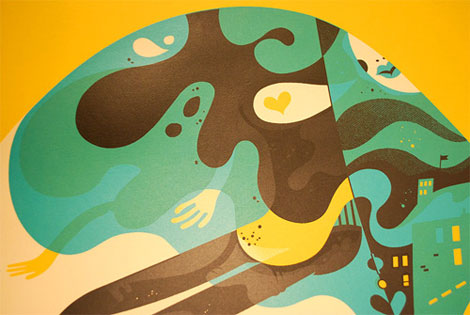
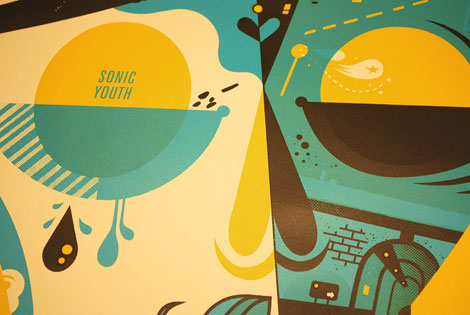
—

How do you pair concepts with your distinct style?
Honestly, we’ll try out anything. We do tend to gravitate towards concepts that give us a lot of opportunities to pack in little details and stuff that’ll give the work some personality or a point of view. But a lot of times it has less to do with the subject matter at hand than just approaching it the right way, finding the angles, creating a subtext.
How do you know when a project is complete?
You might be asking the wrong people. Sometimes they’re done just because there’s no more time left. Doneness is a subjective concept, but you know when something looks overworked. So what we’re usually trying to do is to walk a project right up to that line, and not go over it. But really, given unlimited time, we could (and would) revisit everything we’ve ever made and fix it, like Hergé with the Tintin books, adding and editing in perpetuity. And then we drop dead.
If you could recommend 3 books & 3 albums to another designer, what would they be?
Designers in general are too fussy about music. Stop trippin’, designers. It’s late summer, which is a great time to listen to Ariel Pink or Wavves. Cherry Red just re-issued “Pleasure” by Girls at Our Best, so pick that up too.
Get that Dorfsman & CBS book. Then read a book that’s at least 50% words (your choice, but no teen vampires or cat-narrated murder mysteries, por favor). And then maybe something by Michael Lewis, because designers need to get way smarter about the marketplace, and he’s good to read.

What is one thing most people don’t know about you?
We’re currently taking driving lessons for the first time. We’re going to show that test (designed for 15-year-olds) who’s boss.
—
I’d like to thank Melissa and JW for revealing some of their secrets and making this interview happen! Be sure to check out their website and store, Ye Olde Shop, for their latest and greatest prints (I want one of everything!). Don’t forget to sign up for their newsletter too, which always contains a chock full of funnies and news.
———————-
Enjoy reading this interview? Please leave a note in the comments and consider signing up for our tasty free grain edit RSS feed.
Also worth checking: Invisible Creature interview.
———————-
Tagscontemporary, Features, graphic-design, Illustration, USA
09.03.09 in Features by Grace Danico
Share on Facebook


















